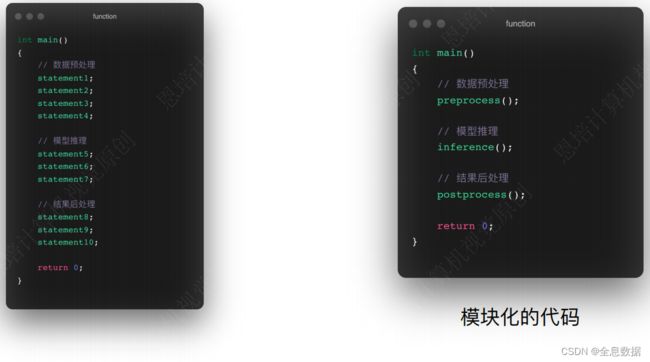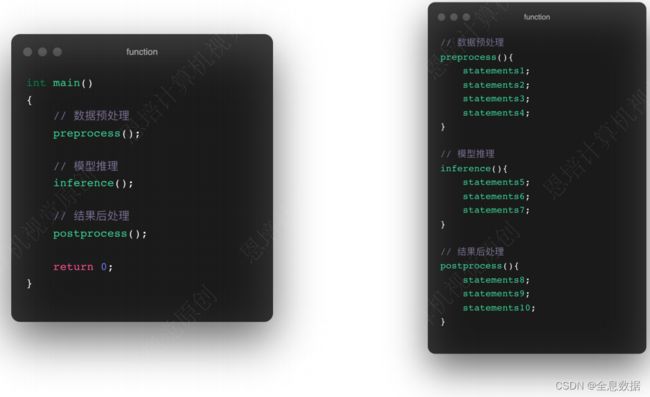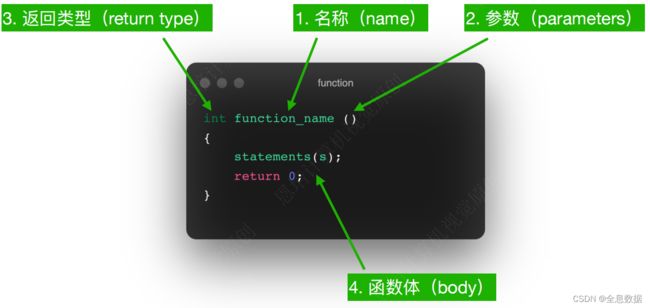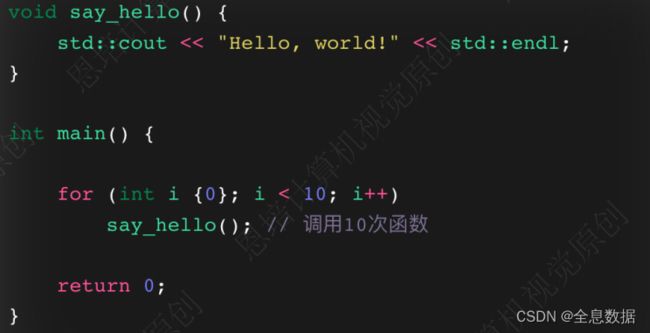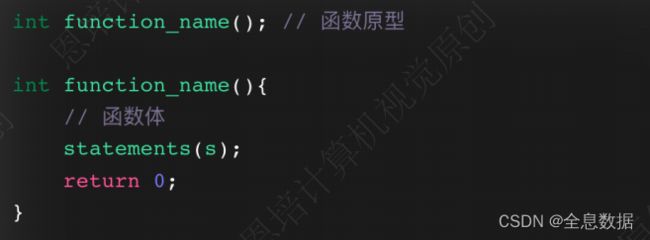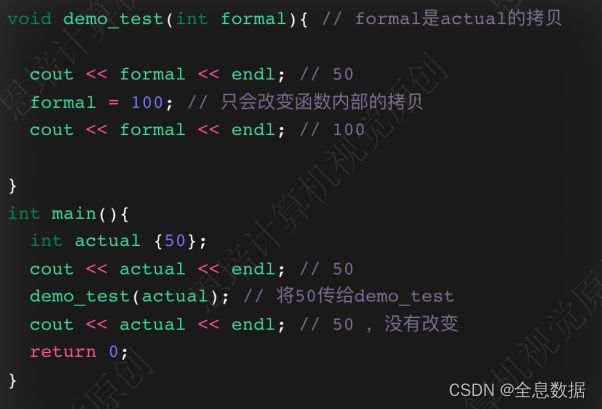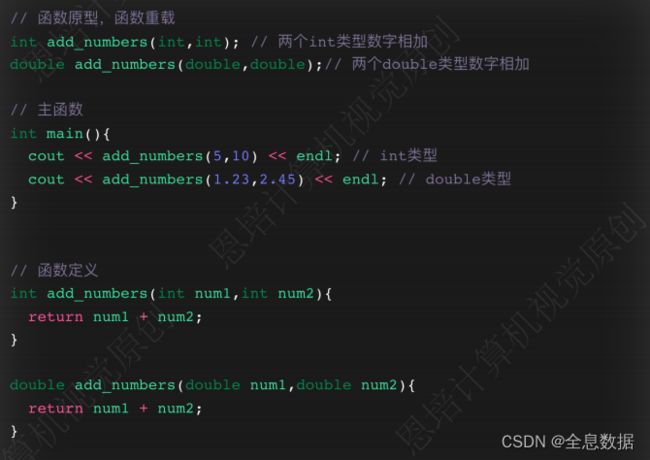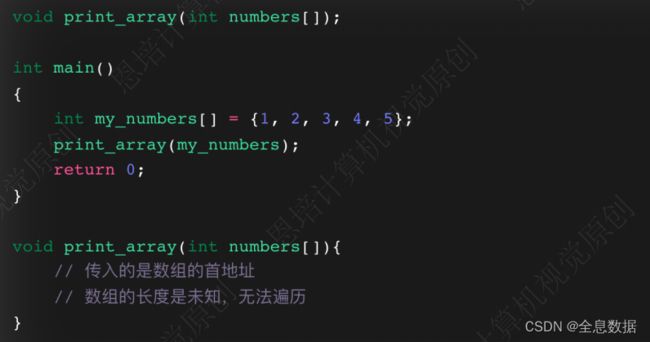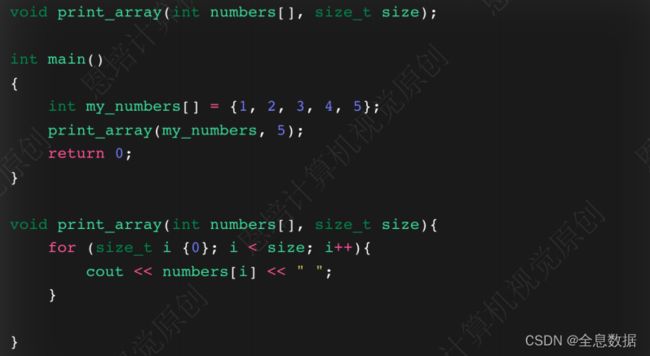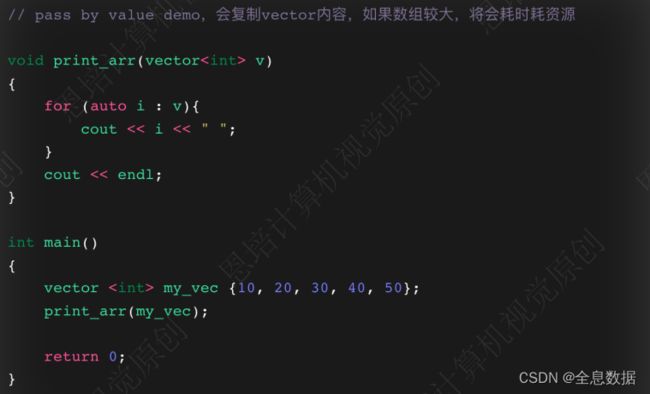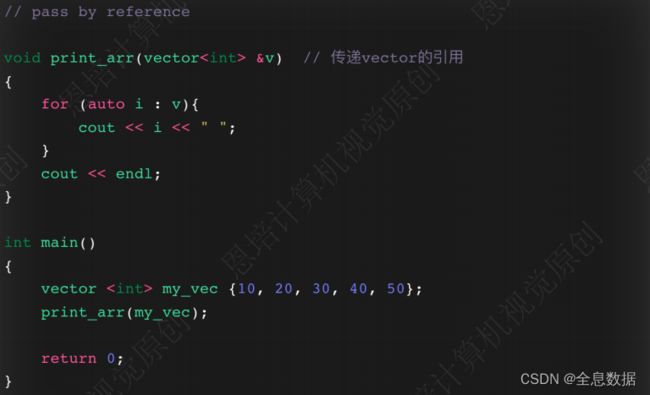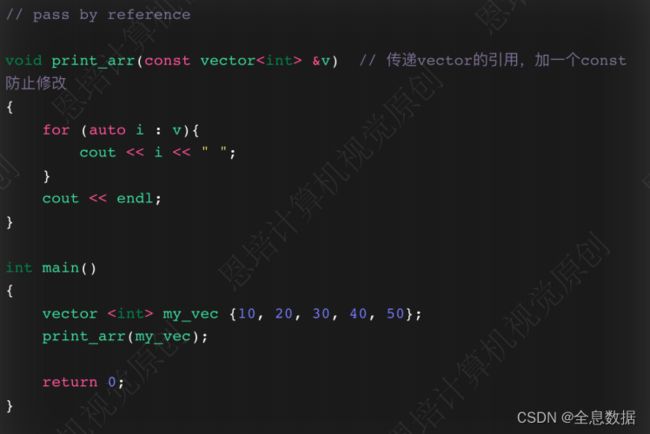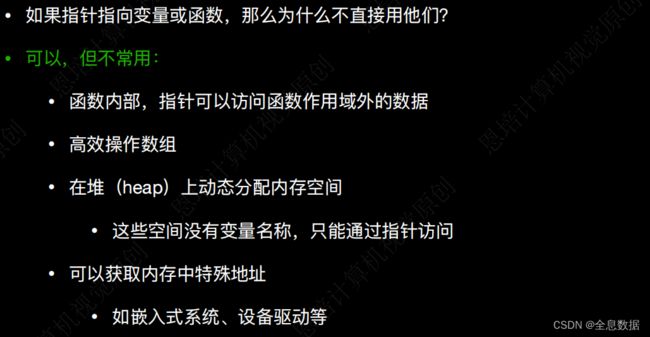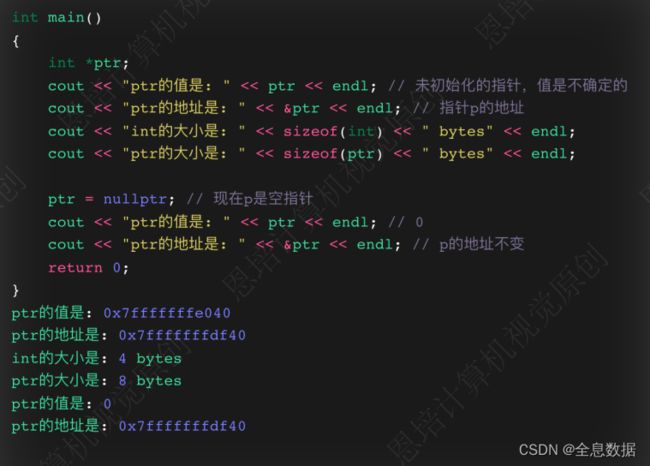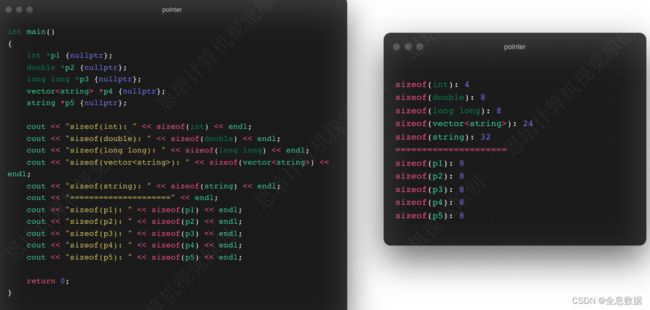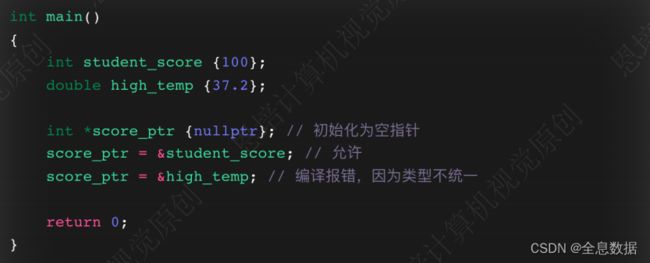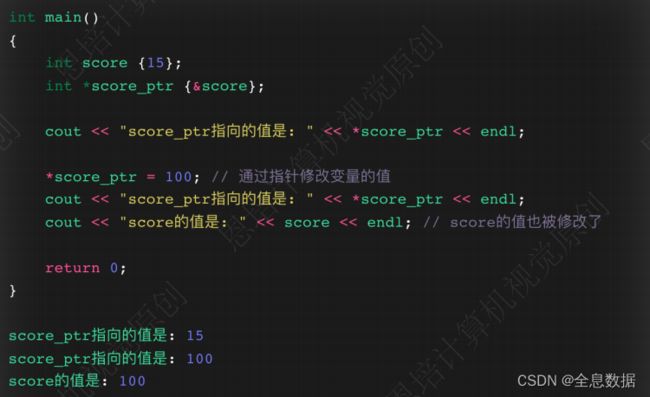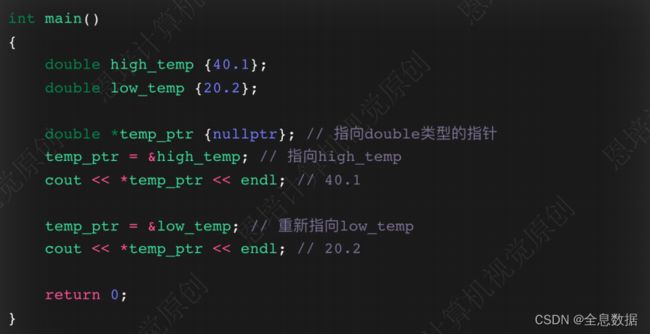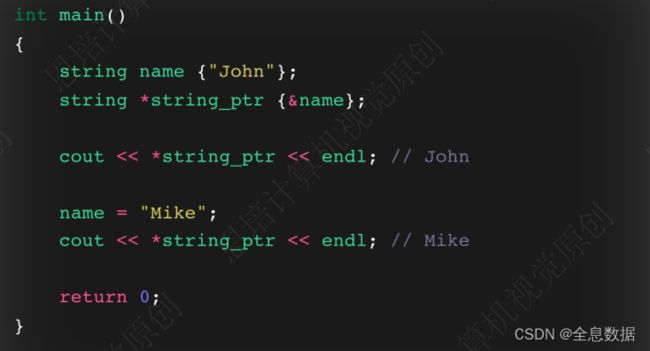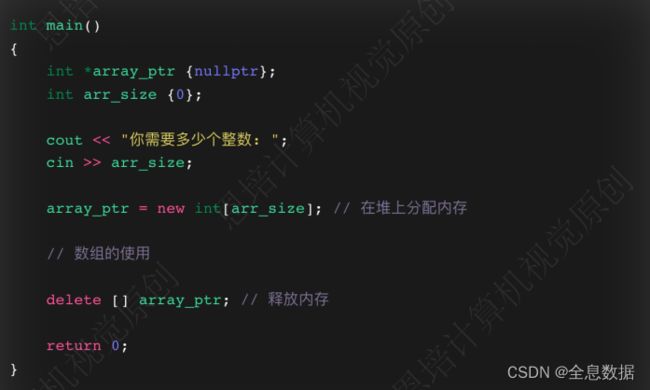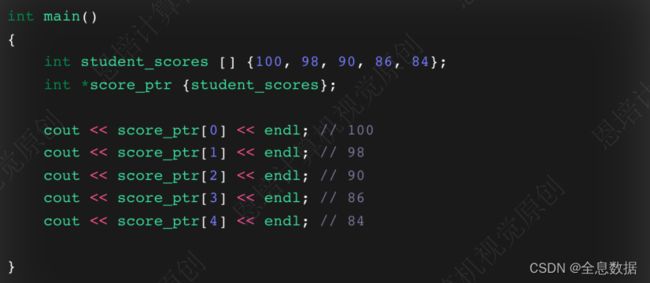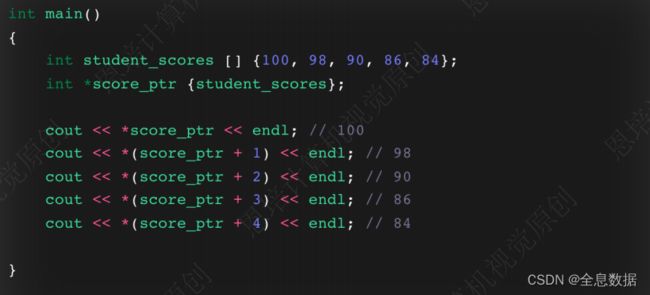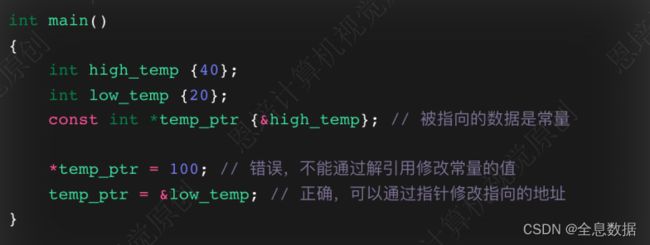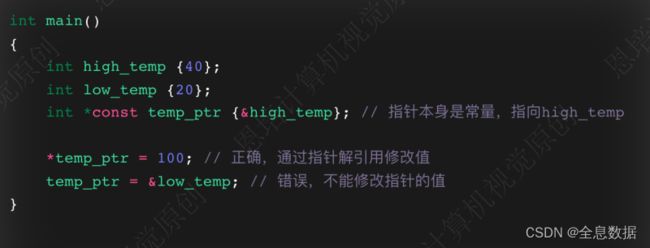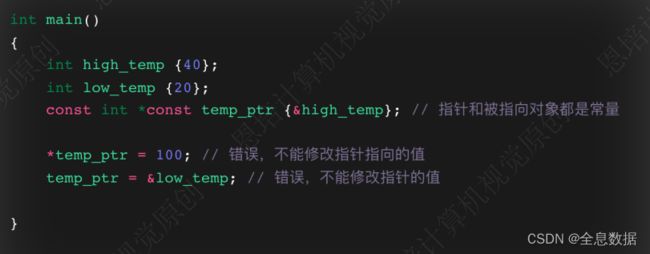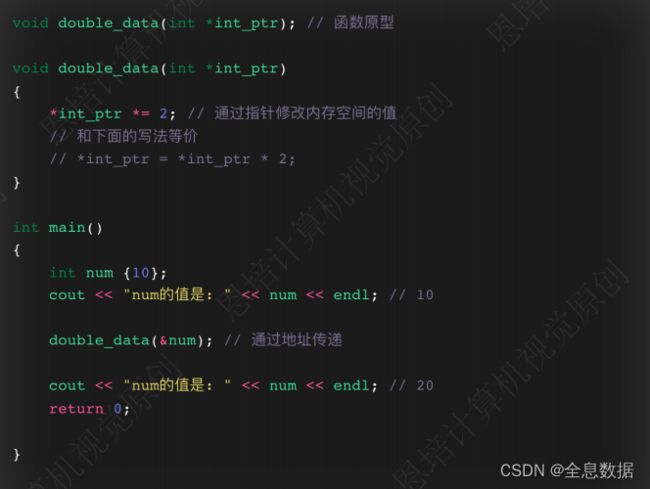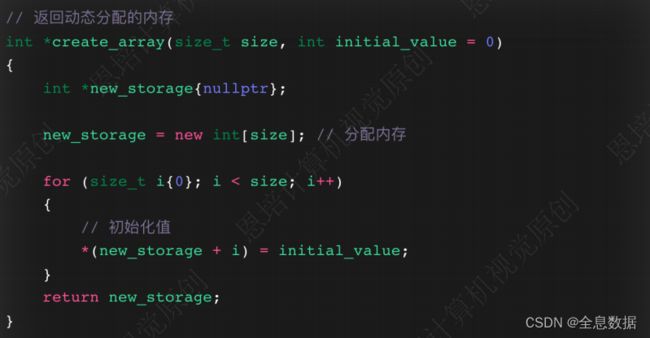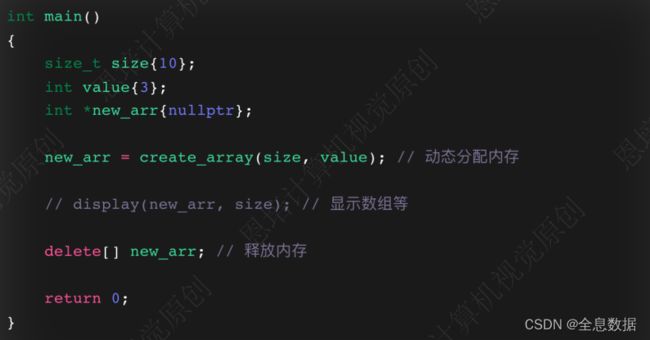C++进阶语法之函数和指针【学习笔记(二)】
文章目录
-
-
- 1、C++ 函数
-
- 1.1 函数的定义
- 1.2 函数原型(function prototypes)
- 1.3 参数(parameter)——值传递(pass by value)
- 1.4 重载(overloading)
- 1.5 函数传参——传递数组(array)
- 1.6 函数的传参——引⽤传递(pass by reference)
- 1.7 函数的传参——vector Demo
- 1.8 函数调⽤机制
- 2、C++ 指针(pointer)
-
- 2.1 指针(pointer)介绍
- 2.2 指针的解引⽤(dereference)
- 2.3 动态内存分配(dynamic memory allocation)
- 2.4 指针和数组的关系
- 2.5 const和指针
- 2.6 函数指针传参
- 2.7 函数返回指针
- 2.8 指针、引⽤对⽐——回顾⼀下引⽤(reference)
-
1、C++ 函数
什么是函数?
• C++ 程序
• ---->C++ 标准库(functions 和 classes)
• ---->第三⽅库(functions 和classes)
• ---->⾃定义的functions 和 classes
• 函数让我们的程序更加模块化
• ---->让代码解耦,分成按业务,按逻辑的单元
• ----> 提⾼代码复⽤性
1.1 函数的定义
• 函数名称
• 参数列表
-----> 传给函数的变量
-----> 变量类型需声明
• 返回值类型
• 函数体
-----> 函数被调⽤执⾏的部分
-----> 花括号 { }内部
C、函数的定义——⽆返回类型
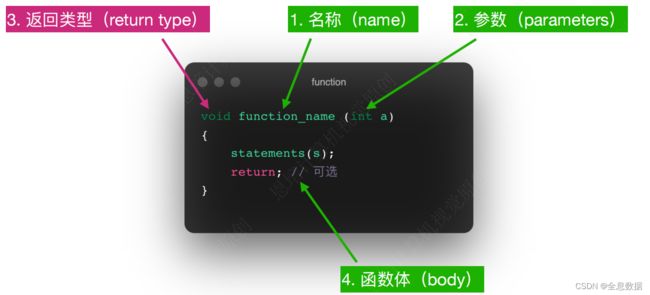
D、 函数的定义——多个参数
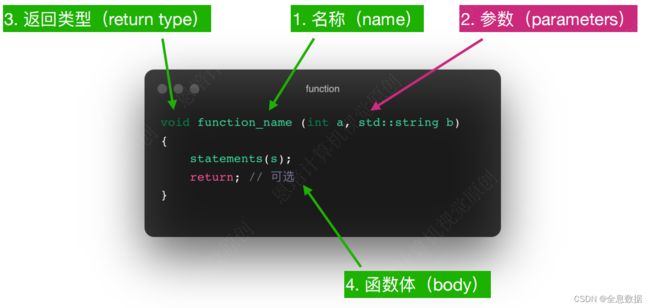
E、函数的定义——函数的调⽤(calling)
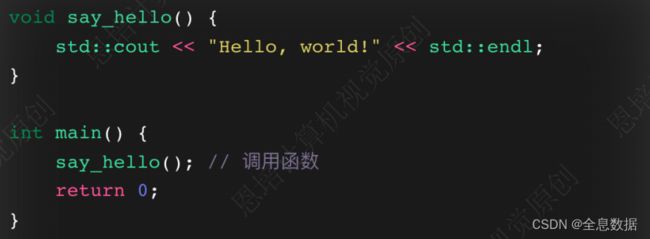
代码:
#include 1.2 函数原型(function prototypes)
编译器要求:使⽤函数前必须“⻅过”这个函数
• 先定义函数再调⽤
----->• 适⽤于⼩型程序,不适⽤于⼤型项⽬
• 使⽤函数原型
----->• 告诉编译器函数定义必要的信息
----->• 也称为前向声明(forward declaration)
----->• 放在程序开始的部分,在#include之后
----->• 或者放在头⽂件(header files)(.h)中
函数原型中的参数可以写参数名称也可以不写参数名称,因为编译器关注的是参数类型,
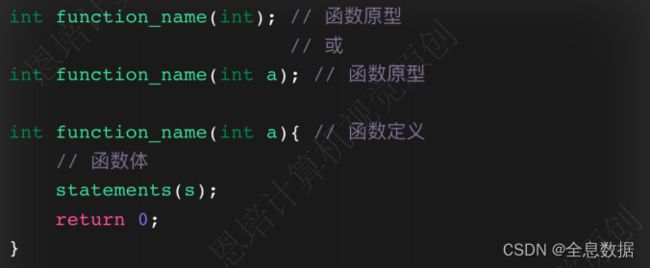
代码:
先定义函数原型,再编译就不会报错
#include 1.3 参数(parameter)——值传递(pass by value)
• 当我们传递数据给函数时,其实⽤的是值传递(pass by value)
• 数据的拷⻉会传给函数
• 函数内部的代码不会改变我们传给它的变量
• 形参(formal parameters)与实参(actual parameters):
------>• 形参(formal parameters):函数定义语句中的参数
------>• 实参(actual parameters):调⽤函数时传递的参数(arguments)
代码:
#include 1.4 重载(overloading)
⼀组函数具有相同函数名,不同参数列表
代码:
#include 1.5 函数传参——传递数组(array)
• 数组元素并没有复制!
• 数组变量名称表示第⼀个元素在内存中的地址——这个地址才被复制了
• 函数内部⽆法知道数组⼤⼩(数组⼤⼩需要额外传参)
• 声明参数 numbers是常量(只读 read-only)
代码:
#include 1.6 函数的传参——引⽤传递(pass by reference)
• 有时希望在函数体内部改变实参的值
• 需要实参的地址
• 类似数组⽅式改变原始实参,别的类型能否⽀持?
• 可以使⽤引⽤传参给函数,形参会变成实参的⼀个别名(alias)
代码:
#include 1.7 函数的传参——vector Demo
通过值传递,内存会重新开一处地址存储vector的内容,如果vector较大,将会耗时耗资源,
而通过vector的地址传递,内存就不会再开一处地址存储,
示例代码:
#include 1.8 函数调⽤机制
1、 使⽤函数调⽤栈(function call stack)
----->• 类⽐⼀摞书
----->• LIFO(后⼊先出,last in first out)
----->• ⼊栈(push):在栈顶添加记录
----->• 出栈(pop):从栈顶移除记录
2、 栈帧(stack frame)或活动记录(activation record)
----->• 每次函数被调⽤,⼊栈⼀条新的活动记录;
----->• 函数结束,活动记录出栈移除,返回⾄调⽤函数的位置
----->• 局部变量(local variables)和函数会在栈上分配空间
3、 栈的⼤⼩有限,超出会栈溢出(stack overflow)
代码1:
#include 代码2:
#include 2、C++ 指针(pointer)
2.1 指针(pointer)介绍
1、 指针是变量
------>• 变量的值是⼀个地址
2、指针的值可以存储哪些地址?
------>• 另⼀个变量
------>• 函数
3、⽐如:int a = 20,可以声明⼀个指针指向它
指针的大小都是一样的,但指针指向的变量大小可能就不一样;需要区分指针和指针指向的变量的关系
• 编译器需要检查指针变量存储地址的类型
D、重要概念
• & 地址操作符
• 指针也是⼀个变量(variable),所以它的值可以改变
• 指针可以为null
• 指针可以不初始化
代码:
#include 2.2 指针的解引⽤(dereference)
• 获取指针指向的数据——解引⽤
#include 2.3 动态内存分配(dynamic memory allocation)
• 在堆(heap)上程序员⾃⼰分配内存空间;
• 回忆下C++ 数组(array)
------>• 使⽤数组需要知道数组⼤⼩,并且数组⼤⼩是固定的;
------>• Vector容器⼤⼩可以动态调整
• 使⽤指针获取堆上刚分配的内存空间
• 使⽤new 关键字 分配内存空间
• 使⽤delete 关键字 释放内存空间
• 使⽤new[ ] 为数组分配内存空间
• 使⽤delete[ ] 释放内存
代码:
#include 2.4 指针和数组的关系
• 数组变量名称的值是数组第⼀个元素的地址;
• 指针变量的的值是⼀个地址;
• 如果指针指向的类型和数组元素的类型⼀致,那么指针和数组名称⼏乎是等价的
代码:
#include 2.5 const和指针
• 指针可以操作:地址及被指向的对象,可以分为以下3种情况:
------>• 被指向的对象是常量(pointers to constants)
------>• 指针本身是常量(constant pointers)
------>• 指针本身和被指向的对象都是常量(constant pointers to constants)
A、被指向的对象是常量
• 被指向的对象是常量,不可以通过指针改动
• 指针本身可以改变
B、指针本身是常量
• 被指向的对象可以通过指针改动
• 指针本身不可以改变
C、指针本身和被指向的对象都是常量
• 被指向的对象不可以改动
• 指针本身不可以改变
代码:
#include 2.6 函数指针传参
• 使⽤指针、解引⽤实现函数引⽤传参
• 函数的形参是指针
• 实参可以是指针或⼀个变量的地址
代码1:
#include 代码2:
#include 2.7 函数返回指针
• 函数可以返回指针:
------->• Type *function( );
• 返回哪些指针:
------->• 函数内部动态分配的内存空间
------->• 传⼊的数据
• 不能返回函数内的局部变量
不能返回函数内的局部变量,如下面的示例,如果返回的是函数内的局部变量,随着函数运行结束,同在栈上的 size 变量也会被释放,size 的地址有可能被其他新的变量所占用,如果使用解引用指向其他变量就有可能造成程序的 bug,
代码:
#include 2.8 指针、引⽤对⽐——回顾⼀下引⽤(reference)
引用是变量的替身或别名
引用本身是一个常量的指针
指针、引⽤的对⽐, 其中我对引用传值中不支持指向其他变量有疑惑,
代码:
#include 